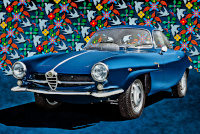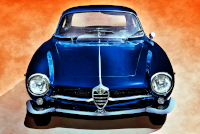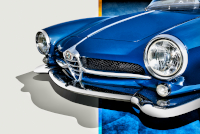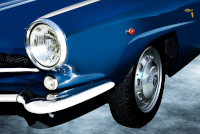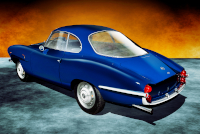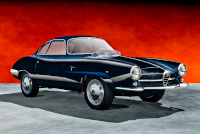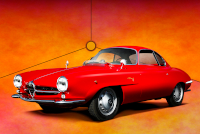Location:
RM Sotheby's, Miami, 2024
Prologue:
At last we've returned to the Sprint Speciale, second run after chassis #AR10120-10117, the red 1960 example. Whereas I debated for some time including an uncatalogued navy example from 1962, whose images date back to 2010, this stellar Bluette car from 1961 offers the chance to update visuals on a high-definition sensor.
For the main illustration I drafted an Italian folk art motif to layer behind the car. I might have crowded the design, though I like the effect, how the imagery plays off the automotive design—swallows and doves and flowers. Except that the work stalled me a little, perhaps too extensive, and completing this profile took far too long and broke my momentum.
The impetus behind this work is indeed to depict more of the nose and tail features—the tail in particular—because the Sprint Speciale shape is so remarkable. And I would have included more details if not for the hard Miami reflections. At the very least, I've taken note of a few good compositions not shown here and may re-shoot them if the chance arises. The Sprint Speciale is a good topic to indulge, and could become a concerted subfocus within the Alfa Romeo portfolio. We'll just need to settle on the best direction, and do the work more efficiently.
- - - - - - - - - -
► Image Source: Nikon D750 (24.3 MP)
References:
- Czap, Nick. "Museo Storico Alfa Romeo: The Catalogue" Giorgio Nada Editore, Milano, Italia. 2015, page 132-133
- RM Sotheby's: The 2024 auction listing for #AR00120-01241.
We trod the territory of Franco Scaglione's design in reviewing the red 1960 example, its descendance from the Bertone Berlinetta Aerodinamica Tecnica (BAT) series, and its relation to the C-52 Disco Volante.
To summarize without needless repetition, the Sprint Speciale began in prototype form at the 1957 Turin Motor Show, appeared in 1960 as the Giulietta Sprint Speciale with a 1.3 litre motor, became the Giulia Sprint Speciale in 1963 with a 1.6 litre motor, and continued in production to 1966. This production run is rather long for a special berlinetta, as Alfa Romeo capitalized to the fullest on the bounty of Scaglione's prolific design exercises.
In the Italian school, the Sprint Speciale advances concepts celebrated in the early 1950s by Giovanni Savonuzzi, whose Ghia Supersonic design patterns that of Scaglione's BAT exercises. But moving into the next decade, designers adopt more formal aerodynamic concepts. Though still quite artistic, these concepts expel the fin era in favor of low lines and Kamm tails, all in the name of efficiency. Bridging the late 1950s and early 1960s, the Sprint Speciale is perhaps no less eccentric, but much more intentional in how the shape performs.
First intended to race, the production variant emerged a bit portly, instead filling the role of roadway darling, a not unappreciated role considering so many of Alfa's period sweethearts are either open cars or straighter closed cars of the three-box architecture school. The Sprint Speciale is of course neither, a wholly curvaceous treat unlike any other in the Alfa Romeo catalogue (save for those experimental cars of Scaglione's hand). And on contemporary roads, perhaps no car approached the Sprint Speciale's particular brand of eccentricity save for the Panhard CD.
We have also noted the drag coefficient and its ambiguous meaning, reported by some at a mere .28. But whether this figure applies to any example of the roadgoing Sprint Speciale is immaterial, because the design generates too much lift. Hence the deflector on the rear bonnet edge. Suffice to say, the Sprint Speciale is flying sauceresque, though more complex in detail.
RM report that this blue example landed at la Società per il Commercio dei Prodotti Alfa Romeo in Lugano, Switzerland in November of 1961, just after its build in October. Chassis #AR177216 remained in Europe until 2010, when the car came to Indianapolis and began a full restoration. RM suggest that the high level of restoration provided to this car is unusual, which hints at the superlative (as it is their prerogative to do so as broker). But then why not? The result is charming, a beautiful example for those who understand that the fantastical admits some degree of the peculiar.
Motor: 1,290 cc straight 4-cylinder, alloy block, alloy hemi-head | 74 mm x 75 mm | 9.7:1 compression
Valvetrain: DOHC, chain-driven, 2 valves per cylinder
Aspiration: twin Weber 40 DCOE/3 carburetors
Power: 97 bhp at 6,500 rpm
Drivetrain: 5-speed gearbox, rear-wheel drive
Front Suspension: independent via wishbones, coil springs, hydraulic dampers, anti-roll bar
Rear Suspension: live axle located by trailing arms and a triangulated central link, hydraulic dampers
Architecture: pressed steel unitary construction
Kerb Weight: 950 kg (2,094 lbs)
Wheelbase: 2,250 mm (88.58 in)
Top Speed: 183 km/h (113.7 mph)
Etymology:
The Giulietta Sprint Speciale came to market following the lightweight Giulietta Sprint and its up-rated Sprint Veloce cousin. Bertone crafted the prototipo in 1957 using a steel shell with aluminum bonnet, doors, and decklid. The production car is steel. We include the chassis number, the first part of which, '10120,' indicates the factory's Tipo 101.20 designation, identifying the car's place in Tipo 750/101 production.
Figures:
According to the factory catalogue, Alfa Romeo produced 1,252 Giulietta Sprint Speciale cars from 1959 to 1962. The following year, the Giulietta Sprint Speciale became the Giulia Sprint Speciale, and production continued until 1966.
Value:
#AR00120-177216 sold for $100,800 at RM Sotheby's Miami auction in February of 2024.
As I mentioned, the profile on chassis #AR10120-10117 is the first Sprint Speciale on 12cylinders. I do not wish to duplicate the aesthetic discussion, and rather suggest the reader take both pieces in concert.
La Bluette: Concerning Aerodynamics in French and Italian Auto Design
It's fitting that this 1962 example is blue; the color forces us to consider Scaglione's design relative to period French exercises. In particular, the Sprint Speciale exercise that began in 1957 patterns the aerodynamic small capacity cars of Deutsch-Bonnet, progeny of Charles Deutsch, culminating in the 1962 Panhard CD.
The little blue French cars share the Sprint Speciale's tiny tank streamlining, though perhaps without the flying saucer cues. But both design series—and again particularly the Panhard CD—share a very similar Kamm tail. The chrome accents on the rear quarters of the CD are even close replicas of the Sprint Speciale, though the light configuration is rudimentary in comparison. Both use a tapertail effect, but the CD is altogether smooth and soapy, whereas the Sprint Speciale incorporates curves from the rear arches into the tail light clusters and ornaments the lower edge in complementary chrome.
In any case, the Panhard CD is perhaps the closest design contemporary to the Sprint Speciale.
Tail Reduction: Kamm Style on the Sprint Speciale
Enfin, we can observe the tail shape properly. The rear canopy tapers, but also bulges, which creates a gentle bow in the deck. The bow blends into curt brows on either edge, finishing off the rear wheel arches.
Twin tail lights fit vertically within the brows, accented by a third light set into the long chrome strake. The tail panel bends subtly around the back, and chrome along the lower bout makes the surfaces reflective, enunciating the multi-planar curves.
The tail echoes the nose primarily in its eyebrow treatment at the corners, which pair corner bumps of the front guard. And the chrome strakes behind the rear wheel arches balance the brows over the front.
Little Longbow: The Low Point Principle
In honor of aerodynamic efficiency, the leading point of the nose and the terminal point of the tail are about equally low. This point to point bow gives the car a long, bulbous shape. With its rounded flanks, vestige of the Disco Volante, the Sprint Speciale appears awkward in sidelong perspectives, angles in which a particular section comes to the fore and dominates the shape.
The leaping front quarters, the curved canopy, and the long-low haunches sometimes seem out of proportion. But then at certain angles the shape works perfectly. An odd composition this, difficult to capture but fun to dissect.
Last Updated: Mar 26, 2025

